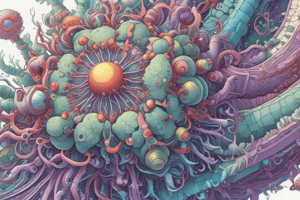Podcast
Questions and Answers
The taxonomic hierarchy in order is?
The taxonomic hierarchy in order is?
Domain → Kingdom → Phylum → Class → Order → Family → Genus → Species
List the three domains of life.
List the three domains of life.
Bacteria, Archaea, Eukarya
What are the six kingdoms of life?
What are the six kingdoms of life?
Eubacteria, Archaea, Protista, Fungi, Plantae, Animalia
Which of the following is a key difference between prokaryotic and eukaryotic cells?
Which of the following is a key difference between prokaryotic and eukaryotic cells?
What does a node on a cladogram represent?
What does a node on a cladogram represent?
What are cladograms?
What are cladograms?
What are traits in the same clade?
What are traits in the same clade?
Are viruses living organisms?
Are viruses living organisms?
Describe the two viral replication cycles.
Describe the two viral replication cycles.
Can a virus contain both DNA and RNA?
Can a virus contain both DNA and RNA?
What is a bacteriophage?
What is a bacteriophage?
What was the first discovered plant virus?
What was the first discovered plant virus?
What is concerning about the Influenza virus?
What is concerning about the Influenza virus?
List the shapes of bacteria.
List the shapes of bacteria.
Which kingdom contains multicellular decomposers?
Which kingdom contains multicellular decomposers?
Which kingdom contains autotrophic organisms?
Which kingdom contains autotrophic organisms?
What distinguishes animals from other kingdoms?
What distinguishes animals from other kingdoms?
What causes antibiotic resistance in bacteria?
What causes antibiotic resistance in bacteria?
How does pesticide resistance develop?
How does pesticide resistance develop?
Who developed the theory of evolution?
Who developed the theory of evolution?
Define descent with modification.
Define descent with modification.
List the four principles of natural selection.
List the four principles of natural selection.
What is survival of the fittest?
What is survival of the fittest?
What is an example of natural selection?
What is an example of natural selection?
What are homologous structures?
What are homologous structures?
Define vestigial structures.
Define vestigial structures.
How does embryology relate to evolution?
How does embryology relate to evolution?
How does molecular biology relate to evolution?
How does molecular biology relate to evolution?
What are the conditions for Hardy-Weinberg equilibrium?
What are the conditions for Hardy-Weinberg equilibrium?
Write out the Hardy-Weinberg equation.
Write out the Hardy-Weinberg equation.
Explain how to calculate q from a recessive trait.
Explain how to calculate q from a recessive trait.
Explain how to calculate p from q
Explain how to calculate p from q
Flashcards
Taxonomic Hierarchy
Taxonomic Hierarchy
A system for classifying organisms from broad (domain) to specific (species).
Three Domains of Life
Three Domains of Life
Bacteria, Archaea, and Eukarya; the highest level of classification.
Six Kingdoms of Life
Six Kingdoms of Life
Eubacteria, Archaebacteria, Protista, Fungi, Plantae, Animalia.
Prokaryotic vs Eukaryotic Cells
Prokaryotic vs Eukaryotic Cells
Signup and view all the flashcards
Node on a Cladogram
Node on a Cladogram
Signup and view all the flashcards
Cladograms
Cladograms
Signup and view all the flashcards
Traits in the Same Clade
Traits in the Same Clade
Signup and view all the flashcards
Viruses as Living Organisms
Viruses as Living Organisms
Signup and view all the flashcards
Viral Replication Cycles
Viral Replication Cycles
Signup and view all the flashcards
Genetic Material in Viruses
Genetic Material in Viruses
Signup and view all the flashcards
Bacteriophage
Bacteriophage
Signup and view all the flashcards
First Discovered Plant Virus
First Discovered Plant Virus
Signup and view all the flashcards
Influenza Virus
Influenza Virus
Signup and view all the flashcards
Shapes of Bacteria
Shapes of Bacteria
Signup and view all the flashcards
Kingdom of Multicellular Decomposers
Kingdom of Multicellular Decomposers
Signup and view all the flashcards
Kingdom of Autotrophic Organisms
Kingdom of Autotrophic Organisms
Signup and view all the flashcards
Distinguishing Animals From Other Kingdoms
Distinguishing Animals From Other Kingdoms
Signup and view all the flashcards
Antibiotic Resistance in Bacteria
Antibiotic Resistance in Bacteria
Signup and view all the flashcards
Pesticide Resistance Development
Pesticide Resistance Development
Signup and view all the flashcards
Theory of Evolution Developer
Theory of Evolution Developer
Signup and view all the flashcards
Descent with Modification
Descent with Modification
Signup and view all the flashcards
Four Principles of Natural Selection
Four Principles of Natural Selection
Signup and view all the flashcards
Survival of the Fittest
Survival of the Fittest
Signup and view all the flashcards
Example of Natural Selection
Example of Natural Selection
Signup and view all the flashcards
Homologous Structures
Homologous Structures
Signup and view all the flashcards
Vestigial Structures
Vestigial Structures
Signup and view all the flashcards
Embryology and Evolution
Embryology and Evolution
Signup and view all the flashcards
Molecular Biology and Evolution
Molecular Biology and Evolution
Signup and view all the flashcards
Conditions for Hardy-Weinberg Equilibrium
Conditions for Hardy-Weinberg Equilibrium
Signup and view all the flashcards
Hardy-Weinberg Equation
Hardy-Weinberg Equation
Signup and view all the flashcards
Study Notes
- Taxonomic hierarchy organizes life from broad to specific: Domain → Kingdom → Phylum → Class → Order → Family → Genus → Species.
- The three domains of life include Bacteria, Archaea, and Eukarya.
- The six kingdoms of life are Eubacteria, Archaea, Protista, Fungi, Plantae, and Animalia.
- Prokaryotic cells lack a nucleus and membrane-bound organelles, while eukaryotic cells possess both.
- A node on a cladogram represents a common ancestor.
- Cladograms depict evolutionary relationships based on shared derived characteristics.
- Traits in the same clade are derived characteristics inherited from a common ancestor.
- Viruses are not considered living organisms because they cannot reproduce independently and lack metabolic processes.
- Viral replication cycles include the lytic cycle, which involves immediate replication and destruction of the host cell, and the lysogenic cycle, where viral DNA integrates into the host DNA, remaining dormant before activation.
- Viruses contain either DNA or RNA, but never both, as their genetic material.
- A bacteriophage is a virus that specifically infects bacteria.
- The Tobacco Mosaic Virus (TMV) was the first plant virus discovered.
- The influenza virus mutates rapidly, causing respiratory infections and seasonal outbreaks.
- Bacteria exhibit three primary shapes: cocci (spherical), bacilli (rod-shaped), and spirilla (spiral).
- Fungi belong to the kingdom of multicellular decomposers.
- Plantae is the kingdom of autotrophic organisms.
- Animals are distinguished from other kingdoms by being multicellular, heterotrophic, and lacking cell walls.
- Antibiotic resistance in bacteria is due to the overuse and misuse of antibiotics, leading to natural selection of resistant bacteria.
- Pesticide resistance develops through natural selection, where only resistant insects survive and reproduce.
- Charles Darwin developed the theory of evolution.
- Descent with modification describes species changing over time due to inherited traits from common ancestors.
- The four principles of natural selection are Variation, Overproduction, Adaptation, and Descent with Modification.
- Survival of the fittest refers to organisms best suited to their environment surviving and reproducing.
- Peppered moths exemplify natural selection, with darker moths becoming more prevalent in polluted areas due to better camouflage.
- Homologous structures have similar anatomy but different functions, such as a human arm and a bat wing.
- Vestigial structures are body parts that have lost their original function, like the human appendix.
- Similar embryos suggest a common ancestor, highlighting the role of embryology in understanding evolution.
- Similar DNA and proteins indicate evolutionary relationships, playing a key role in molecular biology and evolution.
- Conditions for Hardy-Weinberg equilibrium include a large population, no mutations, no natural selection, random mating, and no gene flow.
- The Hardy-Weinberg equation is p² + 2pq + q² = 1.
- To calculate q from a recessive trait, take the square root of the proportion of the population with the recessive trait.
Example
- If 9% of a population has a recessive trait (q² = 0.09), then q = √0.09 = 0.3.
- To calculate p from q, subtract q from 1 (p = 1 - q).
Example
- If q = 0.3, then p = 1 - 0.3 = 0.7.
Studying That Suits You
Use AI to generate personalized quizzes and flashcards to suit your learning preferences.




